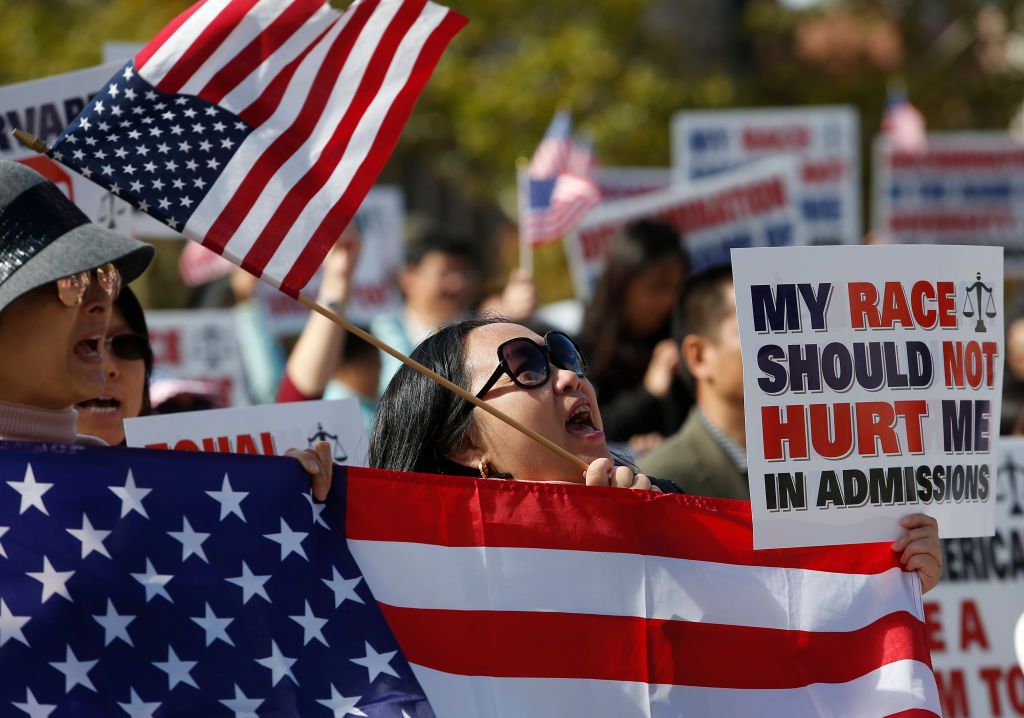Human Rights
Anti-Asian Discrimination Is Real and an Attack on American Values
The self-selection bias of immigrants does not dilute the story.

There are two truths about Asians in America that go unsaid.
The first: Asians are, on average, a model minority in America. I use the phrase “model minority” intentionally because it has become a common and loaded term: sometimes used in the pejorative, sometimes in celebration.
The second: anti-Asian discrimination is real and institutional. I use institutional because of calculated policies by major institutions with consequences that disproportionately affect Asians.
The sad fact is that the first truth—rather than being celebrated—seems to be causing the second.
Let me first acknowledge that “Asian” is a sweeping category. Its breadth means it has averages. It contains a multitude of races, languages, and cultures. I am using it primarily to mean people of South and East Asian descent in America today. I use it only because that’s the best data categorization we have. Asian primarily refers to Chinese, Indian and Filipino that make up ~60 percent of Asians in America. I avoid BIPOC because it is unhelpful on three fronts. It assumes any skin pigmentation is the main driver of racism. Additionally it is a large catch-all group for which no real data is available. Worst of all, the phrase “people of color” is infantilizing.
At its most fundamental, model minority suggests being a law-abiding, productive citizen. Let’s start with crime and incarceration rates. According to the US Department of Justice Asians commit violent crimes at about one-fifth the rate of the total population. That’s the lowest of any group recorded. By a substantial margin.
Being productive means being a net contributor to the financial well-being of the country. US Bureau of Labor Statistics show Asians claim less employment benefits and have higher earnings (according to census data) than any other group. Further, census data shows Asians have the highest rates of business ownership (and growth) and the most success because of hard work and capital. The National Center for Education Statistics show of all degrees in high-paying professional disciplines (law, dentistry, pharmacy, medicine, etc.) 15 percent were awarded to Asians despite being only 6.3 percent of the population. The National Community Reinvestment Coalition highlight that Asians have, unsurprisingly, accumulated real wealth. By now many Asians (and non-Asians alike) reading this will be rolling their eyes at the stereotype. But stereotypes often have more than just a kernel of truth about them.
It is worth understanding the culture of Asians and what we might learn. Let me say again: Asians are not a homogenous group. But the best data I have is at the “Asian” level, so I will work with that and the inherent limitations.
The self-selection bias of immigrants does not dilute the story. Indeed, according to Pew Research more than half of Asians in the US were born outside the US. Yes, many Asians absolutely arrive armed with a degree, often in science and engineering. But most Asians do not arrive with the advantages (“privileges” in today’s ambiguous phrasing) of English as a first language, nor citizenship, nor meaningful wealth, nor social capital. Each of those is a significant hurdle to overcome. And yet overcome them—at an aggregate level—Asians do. Culture is the reason. Part of the reason it is worth zooming in on culture is that it is not immutable. And culture is not a zero-sum game.

Culture is notoriously hard to define. But we can make some common sense guesses to some positive factors especially early in life. How much homework do Asians kids do? How much television do Asians watch? How about underage drinking? Or entanglements with the police? Data from reliable sources like the National Center for Education Statistics, Nielsen, National Center for Biotechnology Information, and US Department of Justice gives us the answers to these questions. Relative to the US population Asian kids do 50 percent more homework, have 35 percent less TV and screen time, are less than half as likely to drink and make up only one percent of all juvenile offenses. The unfortunate “Tiger Mom” stereotype also holds. Asian kids are held to a higher academic expectation than other ethnicities, and Asian parents spend twice as much as others on education.
As those kids move into early their 20s and 30s let’s examine how Asians’ upbringing may have helped them make major lifestyle choices. Asians in America tend to delay marriage and have children at about twice the rate of other groups. Further, family stability is high with around three marriages per divorce, the highest of any other group measure by the National Center for Family and Marriage Research. Those family planning decisions are highly correlated to future wealth. Pick your statistic(s) blindly. But I encourage you to look at the overall portrait.
Given the positive story I am telling, why am I calling out anti-Asian bias? Because the recent “equality of outcome” agenda being pushed is a recent and wholly un-American idea. It disproportionately affects Asians. The equality of outcome goal manifests itself in the camouflaged word: “equity.” It is painfully obvious that different cultures have different values. Why shy from the fact? Different values naturally lead to different outcomes. We all start from a different place in life. We cannot change that. We are all raised in different cultures. We cannot change that. Given those conditions we should strive for a level playing field with clear rules of the game. That is American. That is fairness. That is meritocratic.
Instead, what do we have today?
Harvard and Yale—two of the world’s most prestigious institutions—actively discriminate against Asians. Once controlling for variables, Thomas Espenshade and Alexandria Radford showed Asians face odds multiple times higher than other groups to be accepted to elite colleges. And Asians don’t have sports scholarships to rely on either according to the National Collegiate Athletic Association. The rot is spreading into the public education system. Lowell High School in San Francisco, one of the country’s most prestigious schools with 59 percent Asians is removing the blind, test-based meritocratic admissions process. A similar attempt is underway at Stuyvesant High School in New York (73 percent Asian). And also at Boston Public Schools which would cut the Asian offers by a quarter. Thomas Jefferson High School for Science and Technology in Virgina (72 percent Asian) is changing its admission policies to be more “holistic” from a blind test. In every case the impact falls disproportionately on Asians. What each of these schools is saying is clear. Ability matters less than race. Ethnic diversity is more important than individual excellence. Nothing good lies down this narrow path of thinking.
There is a larger, worrying trend starting to foment. California narrowly defeated Proposition 16. The bill would have allowed the state to consider race and ethnicity in admissions to the state’s public colleges and universities. The University of California has over 40 percent Asian enrollment. Is California the last state to want the right to tilt the playing field in favor of who it deems suitable?

There are over a million Asians on the wait-list to immigrate to the US. The belief is that the country is the most meritocratic in the world. In simple language: hard work pays off. I am an American as of a few weeks ago. I pursued naturalization for two reasons: America’s commitment to freedom of speech and its ideals as explicitly meritocratic. Meritocracy is a noble and progressive cause we should all strive towards. Of course the country has not always lived up to those ideals. But it is for us—Asian and non-Asians, residents and citizens—to pull together in that direction.
Asians, a smorgasbord of cultures including Indian, Chinese, Filipino, Vietnamese, Korean, Japanese among others are demonstrably a model minority in aggregate. Punishing Asians by making the doorway to access the best education in America narrower compared to other groups is shameful and un-American. Major institutions and local governments are enacting these punitive policies, and the model minority is being systematically discriminated against because of its success.






